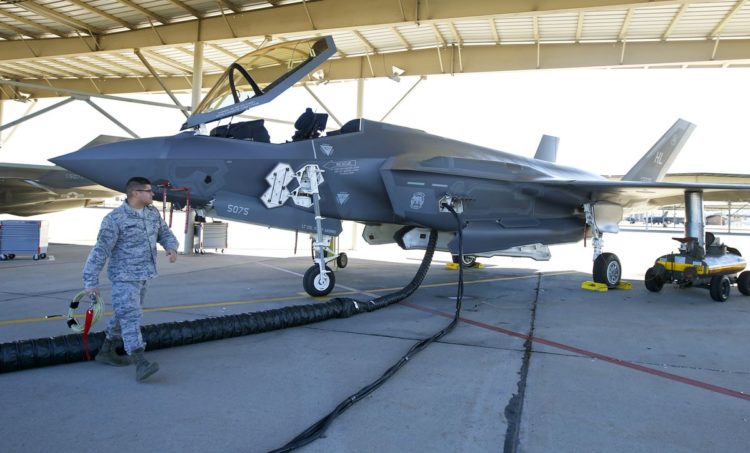F-35s Hobbled by Parts Shortages, Slow Repairs, Audit Finds

published Oct 23, 2017 12:00:10 PM, by Tony Capaccio
(Bloomberg) —
The Pentagon is accelerating production of Lockheed Martin Corp.’s F-35 jet even though the planes already delivered are facing “significantly longer repair times” than planned because maintenance facilities are six years behind schedule, according to a draft audit.
The time to repair a part has averaged 172 days — “twice the program’s objective” — the Government Accountability Office, Congress’s watchdog agency, found. The shortages are “degrading readiness” because the fighter jets “were unable to fly about 22 percent of the time” from January through August for lack of needed parts.
The Pentagon has said soaring costs to develop and produce the F-35, the costliest U.S. weapons system, have been brought under control, with the price tag now projected at $406.5 billion. But the GAO report raises new doubts about the official estimate that maintaining and operating them will cost an additional $1.12 trillion over their 60-year lifetime.
Already, the agency said in the draft obtained by Bloomberg News, the Defense Department “must stretch its resources to meet the needs of continued system development and production while at the same time sustain the more than 250 aircraft it has already fielded.”
Upkeep of the F-35 fleet will become more challenging as the Pentagon prepares for what the manager of the program has called a “tsunami” of new production toward an eventual planned U.S. fleet of 2,456 planes plus more than 700 additional planes to be sold to allies.
Remedies Uncertain
The F-35 program office and Lockheed have identified steps to increase parts availability “to prevent these challenges from worsening” as aircraft numbers increase, the GAO said, but Pentagon documentation indicates “the program’s ability to speed up this time line is uncertain.”
The GAO also disclosed that the F-35B — the Marine Corps version of the fighter that’s scheduled to begin ship deployments next year — won’t have required maintenance and repair capabilities at sea and “will likely experience degraded readiness.”
The GAO said in the draft audit that the 60-year estimate for upkeep of the F-35 has increased despite the Defense Department’s “concerted efforts to reduce costs.”
Ellen Lord, the Pentagon’s new undersecretary for acquisition, highlighted the underlying issue for new weapons systems this month in a speech to an Army audience.
‘Sustainment Side’
“My initial conclusion is we spend an incredible amount of time on the acquisition side” and “very, very little time on the sustainment side,” she said. “When you look over the life-cycle” cost “of most of our programs, it’s about 70 percent on the sustainment side. So we need to get that right.”
Under a congressional mandate, by February the Pentagon must divide its acquisition office into one focused on developing promising technologies and the second on systems acquisition and sustainment.
Asked to comment on the draft report on F-35 repairs, Navy Commander Patrick Evans, a spokesman for Lord, said in an email that Defense Secretary Jim Mattis “has made it clear that the department must focus on doing business more efficiently and cost effectively. To that end, we will review the GAO’s findings, make the appropriate responses directly to the GAO, and continue to work with our partners for the good of the warfighter and taxpayer money.”
A spokesman for the Pentagon’s F-35 program office said “it would be improper for us to comment on an unfinished draft report that has not been publicly released.” The office “has numerous initiatives underway to improve F-35 logistics and sustainment,” spokesman Joe DellaVedova said, citing as an example an “affordability war room” established with Lockheed and engine maker Pratt & Whitney.
“Since its inception, these efforts have reduced sustainment costs by $60.7 billion over the life of the system,” DellaVedova said.
‘Positive Step’
The GAO draft praised as a “positive step” the Pentagon’s establishment of an “integrated master schedule” to better plan sustainment. Still, “parts shortages are expected to continue for several years and may worsen if DoD and the contractor are not able to fully implement these actions,” the GAO said.
The Pentagon plans to increase its annual F-35 purchases to 99 by 2022 from the 70 requested this fiscal year.
Years’ Delay
Repair capabilities for many different F-35 components at six military depots were originally planned for completion by last year “but program officials told us that some capabilities have now been delayed to 2022,” in part because of the Air Force and Navy are “not providing enough funding,” the GAO said. But it said service officials said the F-35 program office failed to “clearly identify some depot requirements in a timely manner.”
The Pentagon faces a funding shortage of about $1.5 billion for fiscal years 2018 to 2023 for F-35 sustainment “as well as significant readiness risks,” the agency said.
The Pentagon’s F-35 program office has Lockheed on contract for a pilot program to provide aircraft maintenance that “to date has not achieved the desired aircraft performance,” the auditing agency said.
Yet the Pentagon continues “to move quickly toward negotiating longer-term contracts — which are likely to cost tens of billions — by 2020,” the GAO said, adding that the government “could find itself overpaying for sustainment support that is not sufficient to meet warfighter requirements.”
Lockheed spokeswoman Carolyn Nelson said in an email the company has not seen the GAO draft but continues to work with the F-35 program office, U.S. military services and international partners “to provide an affordable sustainment solution to support the F-35 program” and “understand every factor of the cost per flying hour and identify disciplined ways we can reduce the overall operations and sustainment costs.”
The company has already reduced the basic unit flyaway cost of the Air Force version by 60 percent, Nelson said.
To contact the reporter on this story: Tony Capaccio in Washington at acapaccio@bloomberg.net To contact the editors responsible for this story: Bill Faries at wfaries@bloomberg.net Larry Liebert
copyright
© 2017 Bloomberg L.P







No Comment